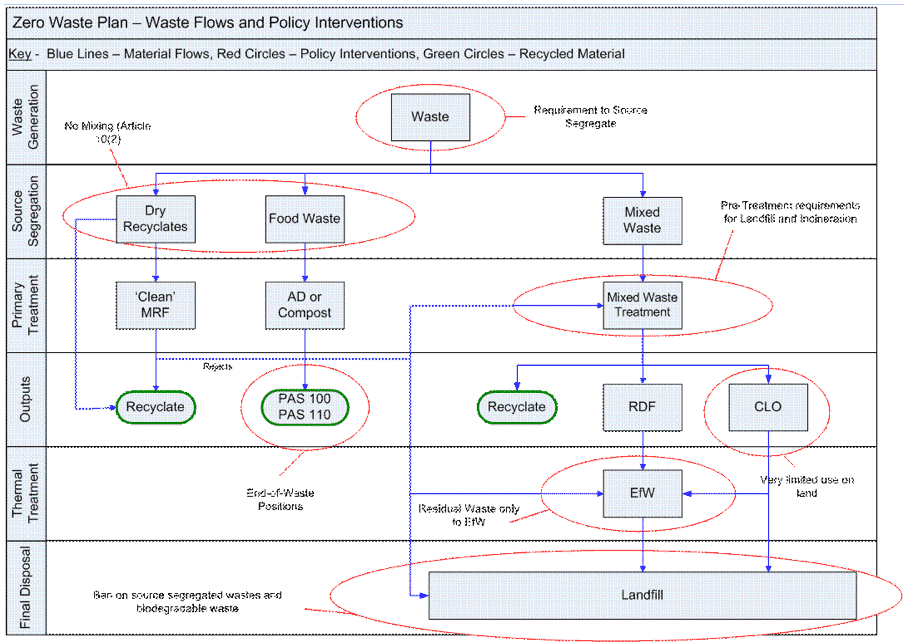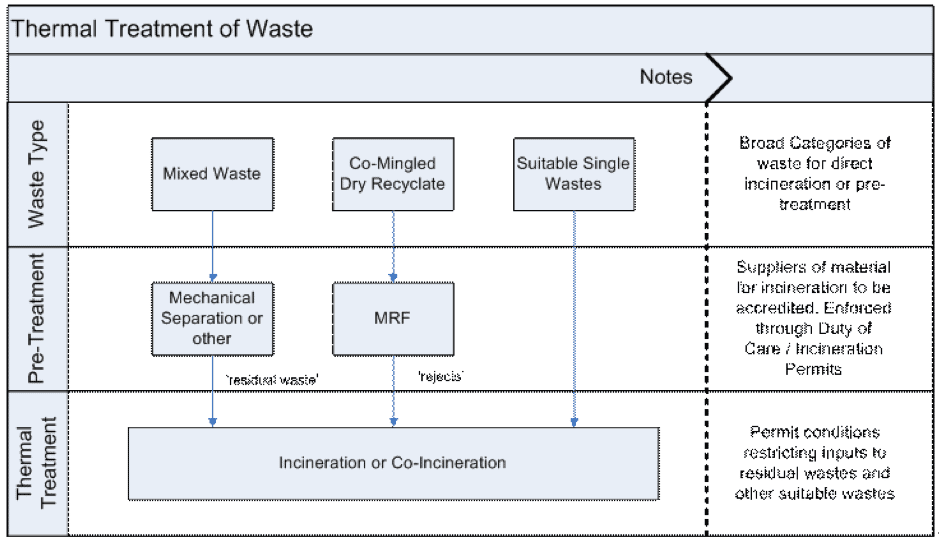Scotland's Zero Waste Plan
Scotland's Zero Waste Plan
Annex C
LANDFILL BANS AND SUPPORTING POLICIES
1. INTRODUCTION
1.1 The Zero Waste Plan indicates that the Scottish Government intends to put landfill bans and associated measures in place to deliver on the commitment to achieve a zero waste society. This Annex sets out how landfill bans have been considered; what they are expected to achieve; and how Scottish Government intends to put landfill bans and supporting measures into practice.
1.2 The purpose of banning certain waste from landfill is twofold: firstly, to ensure that materials which could have been recycled are not disposed of in landfill; and secondly, to protect the environment from the impacts of waste disposal in landfill.
2. BACKGROUND AND OVERVIEW OF RESEARCH FINDINGS
2.1 In 2009 the Scottish Government, along with other administrations, commissioned research on the feasibility of landfill bans as a policy approach. This report can be found at: http://www.wrap.org.uk/wrap_corporate/publications/landfillban.html
2.2 The research was undertaken by Eunomia Research and Consulting and considered two approaches to landfill bans:
- A ban on unsorted waste; and
- A ban on biodegradable waste.
2.3 An important conclusion reached within the research was that landfill bans can be successful in achieving the desired outcomes when accompanied by a package of additional supporting measures.
2.4 The research also highlighted the importance of timing and sequencing when introducing landfill bans. Introducing a ban on biodegradable waste before, or even at the same time as a ban on unsorted waste, could lead to over supply of residual waste treatment facilities. Put simply, landfill bans alone will not lead to high reuse and recycling rates. It would result in a shift from landfill to residual waste treatments such as Mechanical Biological Treatment ( MBT) and Energy from Waste (EfW) facilities.
2.5 The risk is that residual waste treatment prices fall and undermine the economics of Zero Waste Scotland policy aims which give prominence to waste prevention, re-use and closed-loop recycling activities which maximise value-chain opportunities.
2.6 EfW has an important role to play and can make a positive contribution to both renewable energy and climate change targets. However, in order to achieve the high levels of prevention, reuse and recycling outlined in the Zero Waste Plan it is imperative that materials that could be reused or recycled are not directed to mixed waste treatment facilities such as EfW facilities.
2.7 The Scottish Government considers that there is a need to adopt an approach that prevents valuable resource going to landfill, reduces Scotland's climate change impact, and supports high re-use and recycling rates for all waste. Consequently, the Scottish Government intends to introduce regulatory changes that will drive the following:
- Source segregation and separate collection of specific materials.
- Placing restrictions and only allowing suitable waste types to be treated in energy from waste plants.
- Ban specific materials from landfill.
- Place a limit on the biodegradable content of waste which can be landfilled.
These actions should not be seen in isolation but as part of a package of complementary and supporting measures. The undernoted flow chart illustrates how waste materials flow through the waste management system - from waste production and sorting of materials through to intermediate treatment, recovery and disposal.
Figure 1 - Waste Flows and Policy Interventions

2.8 This Annex provides a high level outline explaining how the Scottish Government expects landfill bans and associated measures will work in practice. In the Autumn of 2010 Scottish Government intends to initiate a consultation on the introduction of landfill bans. This will include legislative proposals and the aim will be to put regulations in place in 2011.
3. SUMMARY OF REGULATORY CHANGES
Source segregation and separate collection of specific materials
3.1 The overall objectives of separate collection are:
- to increase the quantity of recyclable materials collected.
- to improve the quality of recyclable materials by minimising contamination.
- to support stable market demand for high quality, high value recyclable materials.
Intended Approach
3.2 The aim would be to take forward legislative measures to require source segregation and separate collection of priority wastes. This could be delivered through amendments to existing statutory mechanisms including Section 34 of the Environmental Protection Act 1990 and the associated Environmental Protection (Duty of Care) Regulations.
3.3 The amendments to the Duty of Care legislation would require (a) producers to segregate recyclable materials and for these to be separately collected; and (b) confirmation being provided on duty of care transfer notes that waste materials have been separately collected, or as appropriate, how they can be subsequently treated.
3.4 The intention is that a requirement be introduced to collect the undernoted wastes separately:
- Food waste, from households and business sectors, such as commercial kitchens, hospitality sector, food retailers and manufactures.
- Materials such as paper/card, metals, plastics, textiles and glass from all sources.
3.5 In taking forward any mandatory requirements to collect materials separately, Scottish Government will have regard to:
- practicalities and the likely timescales required to introduce treatment infrastructure such as Anaerobic Digestion facilities to treat the collected food waste; and
- whether differential sorting requirements are required for local authorities as collection authorities; private waste carriers; commercial/industrial waste producers; and construction and demolition waste producers.
Restricting Inputs to Energy from Waste Facilities (Incineration, Gasification or Pyrolysis)
3.6 The objectives of this measure would be to:
- ensure that waste materials which could have been reused or recycled are not incinerated;
- complement the source segregation and landfill ban measures and ensure that waste management in Scotland does not simply move one step up the hierarchy from landfill to incineration; and
- replace the 25% energy from waste cap for local authority collected municipal waste with an approach that requires equivalent treatment standards for all waste streams and sectors (household, commercial and industrial waste), irrespective of which party collects the waste.
3.7 It is important to note that the purpose of this restriction is to conserve resources rather than adding to current stringent environmental protection measures. The existing Waste Incineration Directive standards and controls are designed to protect the environment and human health.
Intended Approach
3.8 Thermal Treatment plants are regulated under the Pollution Prevention and Control Regulations 2000 ( PPC) by Scottish Environment Protection Agency ( SEPA). Regulatory controls could be introduced to ensure that any waste being treated at energy from waste facilities does not include waste which could have been reused or recycled. This would require amendment of the Pollution Prevention and Control Regulations 2000 to give SEPA clear statutory powers to set and enforce appropriate PPC permit conditions limiting incinerator inputs to:
- Residual wastes i.e. waste remaining after all reasonable efforts have been made to separate out recyclable materials.
- Other suitable waste types where treatment in incinerators is justified on environmental, health or safety grounds. For example, it might be better to burn waste types such as treated wood, sewage sludge and waste oil and to recover heat and power.
3.9 To support the regulatory requirements consideration will be given to the establishment of an accreditation scheme whereby wastes could be certified to be residual. This would assist operators of EfW installations to ascertain whether the waste arriving at their gate had undergone sufficient pre-treatment to be considered residual. This work will be taken forward by Zero Waste Scotland and SEPA working with the industry.
3.10 In moving forward, the Scottish Government will decide whether a transition period should be allowed for existing waste incineration installations to comply. Flexibility would also need to be considered in situations where it would not be environmentally or economically practical to place restrictions but the onus would be placed firmly on the operator to provide evidence that this was justified.
3.11 A flow diagram illustrating how the residual/reject waste material will flow through the system to energy from waste facilities is shown at figure 2.
Figure 2 - Energy from Waste Policy Flow Chart

Ban specific materials from landfill
3.12 Landfill bans are designed:
- to recognise and conserve the resource value of priority waste streams such as plastic, paper, metal, food; and
- to protect the environment from the harmful effects of landfilling particular types of waste e.g. limit on biodegradability.
Intended Approach
3.13 Regulations could be introduced to:
- establish material and property based bans over the next 5 to 10 years.
- ensure the source segregation of recyclable waste streams is not undermined and that as much recyclable material is recovered from the mixed waste stream as possible.
- reduce the biodegradable content of waste to protect the environment from greenhouse gas emissions.
3.14 Under these proposals, it is envisaged that very little waste will be transported directly from producer to landfill. Source segregated materials will be diverted to appropriate end-use re-processor markets. The remaining waste will be pre-treated to extract the remaining recyclable materials, produce Refuse Derived Fuel ( RDF) and reduce biodegradability of any residual waste that is landfilled. These flows are illustrated in Figure 1.
Landfill Bans - Material Bans - Source Segregated Wastes
3.15 The source segregation requirements set out in Section 3.1 - 3.5 provide a clear driver for waste recycling by delivering high quality materials onto the market. Thereafter, it is important that measures are introduced to ensure that materials are not subsequently remixed or disposed of to landfill. Such practice would undermine public confidence in recycling and zero waste policy.
3.16 The timeline for landfill bans must therefore be tied directly into the source segregation requirements detailed in section 3.1 - 3.5. It is considered that requiring source segregation of the key materials (e.g. food waste and dry recyclates) before the corresponding landfill ban comes into effect will give the industry time and confidence to develop the treatment infrastructure required. A possible timeline is illustrated in Figure 3 below.
Figure 3 - Example of matching material bans with source segregation requirements

Landfill Bans - Property Based Ban - Biodegradability
3.17 A ban on biodegradability, when matched with source segregation, performs two key functions;
- acts as a requirement to pre-treat all residual waste and unsorted waste (i.e. where source segregation is unreasonable); and
- protects the environment from the harmful effects of greenhouse gas emissions.
3.18 Such a ban would require that wastes are treated to reduce the biodegradability of the landfilled fraction, either by producing a residual waste stream for incineration (Refuse Derived Fuel) or by removing recyclable materials and biologically treating the remainder.
3.19 It is likely that Mechanical Biological Treatment ( MBT) facilities will provide the bulk of this treatment. These processes are regulated by SEPA either under Pollution Prevention Control ( PPC) or Waste Management Licensing ( WML) Regulations. The biodegradability ban would be implemented after the material bans because it would have the most significant implications for infrastructure and landfill practice. This is also shown in Figure 3.
Intended Approach
3.20 The ban on biodegradable waste would be effectively implemented through the following measures:
- A clear 'threshold' being established, in terms of respirometry, which, for the purposes of the measure, denotes the level at which waste is no longer to be considered as 'biodegradable'.
- A certification scheme being introduced for MBT plants which seek to meet the threshold.
- A requirement to specify on the Waste Transfer Notes whether waste had been pre-treated at authorised facilities or was otherwise deemed to satisfy requirements.
- Landfill operators would be required to inspect Waste Transfer Notes to check that the waste is compliant. Any 'black bag' type waste would be rejected and directed to either incineration or accredited MBT plants.
Scottish Government
June 2010
There is a problem
Thanks for your feedback